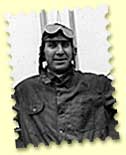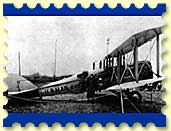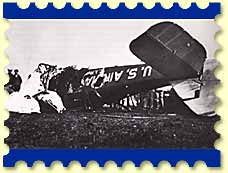Just thirty minutes into his first flight as a U.S. Air Mail pilot, Dean Smith
discovered that his new job could be deadly. Without warning, the engine of his
deHavilland DH-4 airplane suddenly quit. Below lay mile after mile of
forest--and a tiny clearing that was the only hope for a safe landing.
 Fighting rain and a steady wind, Smith steered his tiny, powerless aircraft
toward the clearing. The plane narrowly cleared the bank of trees and swooped
to the ground. But just as Smith's landing gear touched the earth, it slammed
into a hidden ledge, crumpling the DH-4 like a piece of paper. The crash
ejected Smith, who plowed into the brush with his seat belt still across his
lap.
Fighting rain and a steady wind, Smith steered his tiny, powerless aircraft
toward the clearing. The plane narrowly cleared the bank of trees and swooped
to the ground. But just as Smith's landing gear touched the earth, it slammed
into a hidden ledge, crumpling the DH-4 like a piece of paper. The crash
ejected Smith, who plowed into the brush with his seat belt still across his
lap.
A local farmer used his horse and wagon to carry Smith and his mail bags to the
nearest railroad station. There, the bruised and battered pilot continued his
journey by train. He had survived his first crash--but it would not be his
last. In the early days of Air Mail, pilots risked their lives on every flight.
 United States Air Mail service began on May 15, 1918, under the command of
Second Assistant Postmaster General Otto Praeger. Praeger wasn't a pilot, but
he wanted to prove that planes could deliver mail faster than trains could.
Praeger's men flew a variety of aircraft. They soon came to rely on the
deHavilland DH-4. United States Air Mail service began on May 15, 1918, under the command of
Second Assistant Postmaster General Otto Praeger. Praeger wasn't a pilot, but
he wanted to prove that planes could deliver mail faster than trains could.
Praeger's men flew a variety of aircraft. They soon came to rely on the
deHavilland DH-4.
 The DH-4 was small. Its top speed was only about 120 miles per hour, but it
could maneuver easily. Its open cockpit provided little protection from
weather. The DH-4's compass often gave inaccurate readings, so pilots usually
navigated by "contact flying"-- looking at landmarks on the ground such as
roads, rivers, and railroad tracks. Since pilots couldn't fly at night, the
mail was transferred to trains when darkness fell. The DH-4 was small. Its top speed was only about 120 miles per hour, but it
could maneuver easily. Its open cockpit provided little protection from
weather. The DH-4's compass often gave inaccurate readings, so pilots usually
navigated by "contact flying"-- looking at landmarks on the ground such as
roads, rivers, and railroad tracks. Since pilots couldn't fly at night, the
mail was transferred to trains when darkness fell.
The first air mail route ran Washington, DC to New York City. For a skilled
pilot, this route was relatively easy. It featured prominent landmarks and
fields for emergency landings. But when the postal service decided to extend
air mail across Pennsylvania's Allegheny Mountains to Cleveland, danger arose.
The Alleghenies were heavily forested, without many navigation landmarks. They
often lay hidden in clouds, and were home to some of the worst weather in the
East. But since Praeger needed to prove that value of air mail, he pushed
pilots to fly even in rain, snow, and heavy fog.
If anyone could meet the challenge, the daring young pilots of the Air Mail
service could. Many had flown in combat during World War I. Some had performed
in barnstorming air shows. And as Air Mail expanded westward to Chicago and
beyond, these men proved their bravery and resourcefulness again and again.
 Pilot Frank Yeager even discovered a new way to "fly" in heavy fog. He drove
his plane on the ground across 35 miles of foggy prairie, rising into the air
only to hop the barbed-wire fences that stood in his way. Another pilot, Wesley
L. Smith, used a half-empty whiskey bottle as a flight instrument. When the
whiskey in the bottle was level, he knew his plane's wings were level as well.
Pilot Frank Yeager even discovered a new way to "fly" in heavy fog. He drove
his plane on the ground across 35 miles of foggy prairie, rising into the air
only to hop the barbed-wire fences that stood in his way. Another pilot, Wesley
L. Smith, used a half-empty whiskey bottle as a flight instrument. When the
whiskey in the bottle was level, he knew his plane's wings were level as well.
Still, these early pilots faced deadly odds. Between October 1919 and
July 1921, twenty-six Air Mail employees died in plane crashes--more than one
fatality per month. The average air mail pilot could expect to fly less than
two years before dying on the job.
 Thanks to the work of pilots, mechanics, engineers, and administrators, Air
Mail became steadily safer. Starting in 1920, pilots were issued parachutes.
At first, many complained about having to carry them. But once a few lives were
saved, they stopped complaining. New flight instruments and devices such as
headlights on the wings made it easier for pilots to control and land their
planes. And the quality of maintenance improved. Thanks to the work of pilots, mechanics, engineers, and administrators, Air
Mail became steadily safer. Starting in 1920, pilots were issued parachutes.
At first, many complained about having to carry them. But once a few lives were
saved, they stopped complaining. New flight instruments and devices such as
headlights on the wings made it easier for pilots to control and land their
planes. And the quality of maintenance improved.
After a dramatic coast-to-coast flight in February, 1921, proved mail could be
flown at night, the U.S. government set up a system of light beacons and lighted
airfields across the country. The beacons guided night fliers, and the lighted
fields provided safe landing spots.
 That same year, Otto Praeger, was replaced as head of the Air Mail service. The
safety record had already began to improve, and it continued to do so. Between
July of 1921 and September of 1922, not a single Air Mail employee died in a
plane crash. By the end of 1923, pilot safety became a top priority of the Air
Mail service. And soon, as the small planes gave way to larger, more reliable
ones, Air Mail became even safer. That same year, Otto Praeger, was replaced as head of the Air Mail service. The
safety record had already began to improve, and it continued to do so. Between
July of 1921 and September of 1922, not a single Air Mail employee died in a
plane crash. By the end of 1923, pilot safety became a top priority of the Air
Mail service. And soon, as the small planes gave way to larger, more reliable
ones, Air Mail became even safer.
The first years of the Air Mail had been dramatic and dangerous. One of the
pilots who survived was Dean Smith, whose telegram to Air Mail headquarters
after a crash in Iowa serves as one of the best reminders of the wild and wooly
days of early Air Mail. It read simply:
 "On Trip 4 westbound. Flying low. Engine quit. Only place to land on cow.
Killed cow. Wrecked plane. Scared me. Smith."
"On Trip 4 westbound. Flying low. Engine quit. Only place to land on cow.
Killed cow. Wrecked plane. Scared me. Smith."
|
|

